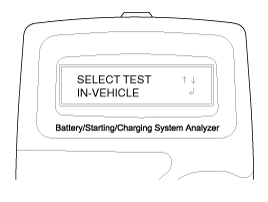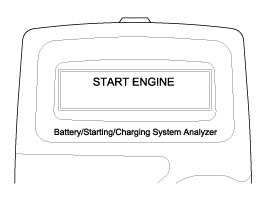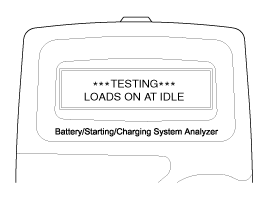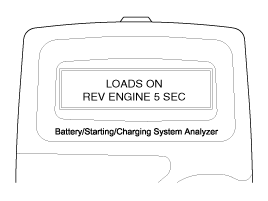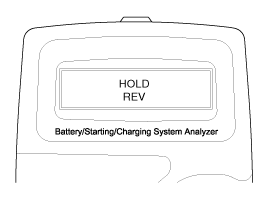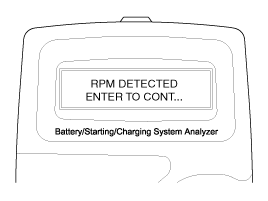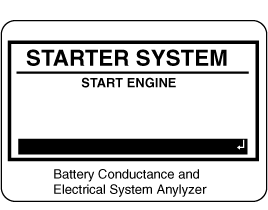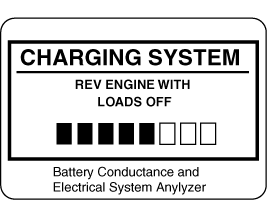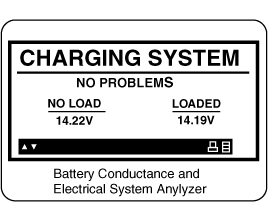Kia Cee'd: General Information / General information
| The Micro 570 Analyzer |
※ Because of the possibility of personal injury, always use extreme
caution and appropriate eye protection when working with batteries.
※ When charging battery by test result, Battery must be fully charged.
To get accurate test result, battery surface voltage must have subsided
ahead before test when you test battery after charged. (See following
Battery Test Results)
|


| 1. |
Connect the tester to the battery.
|
| 2. |
The tester will ask if the battery is connected "IN-VEHICLE" or "OUT-OF-VEHICLE".
Make your selection by pressing the arrow buttons; then press ENTER.
|
| 3. |
Select CCA and press the ENTER button.
|
| 4. |
Set the CCA value displayed on the screen to the CCA value marked on
the battery label by pressing up and down buttons and press ENTER.
|
| 5. |
The tester will conduct battery test.
|
| 6. |
The tester displays battery test results including voltage and battery
ratings.
Refer to the following table and take the appropriate action as recommended
by the Micro 570.
Battery Test Results
[Charge and Retest method after battery charge]
Battery charge
Set battery charger to ‘Auto Mode’ (The Mode that charging current drops
as the battery charges.) and charge battery until charging current down
close to zero or the charger alerts you with an alarm when charge is
complete.
(Minimum charging time recommended: More than 3 hours with Auto Mode
that explained above)
Battery Test after charge
Do not test battery right after the charge. Test battery after battery
surface voltage has subsided as instructed in the following procedure.
Starter Test Procedure
|
| 7. |
After the battery test, press ENTER immediately for the starter test.
|
| 8. |
Start the engine.
|
| 9. |
Cranking voltage and starter test results will be displayed on the screen.
Refer to the following table and take the appropriate action as recommended
by the Micro 570.
Starter Test Results
Charging System Test Procedure
|
| 10. |
Press ENTER to begin charging system test.
|
| 11. |
The tester displays the actual voltage of alternator.
Press ENTER to continue.
|
| 12. |
Turn off all electrical load and rev engine for 5 seconds with pressing
the accelerator pedal. (Follow the instructions on the screen)
|
| 13. |
The message that engine RPM is detected will be displayed on the screen.
Press ENTER to continue.
|
| 14. |
If the engine RPM is not detected, press ENTER after revving engine.
|
| 15. |
The tester will conduct charging system test during loads off.
|
| 16. |
Turn on electrical loads (air conditioner, lamps, audio and etc). Press
ENTER to continue.
|
| 17. |
The tester will conduct charging system test during loads on.
|
| 18. |
Rev engine for 5 seconds with pressing the accelerator pedal. (Follow
the instructions on the screen)
|
| 19. |
The message that engine RPM is detected will be displayed on the screen.
Press ENTER to continue.
|
| 20. |
If the engine RPM is not detected, press ENTER after revving engine.
|
| 21. |
Turn off electrical loads (air conditioner, lamps, audio and etc). Turn
the engine off.
|
| 22. |
Charging voltage and charging system test results will be displayed
on the screen.
Shut off engine end disconnect the tester clamps from the battery. Refer
to the following table and take the appropriate action as recommended
by the Micro 570.
Charging System Test Results
|

|
|

| 1. |
Connect the red clamp to the positive (+) terminal and the black clamp
to the negative (–) terminal.
|
| 2. |
Scroll to and select IN VEHICLE or OUT OF VEHICLE for a battery not
connected to a vehicle.
|
| 3. |
Scroll to and select REGULAR FLOODED, AGM FLAT PLATE, or AGM SPIRAL
where applicable.
|
| 4. |
Scroll to and select the battery’s rating system.
|
| 5. |
Set the selected rating value displayed on the screen to the value marked
on the battery label by pressing up and down arrow buttons.
|
| 6. |
Press ENTER to start test.
|
| 7. |
After several seconds the tester displays the decision on the battery’s
condition and the measured voltage. The tester also displays your selected
battery rating and the rating units.
Battery Test Results
[Charge and Retest method after battery charge]
Battery charge
Set battery charger to ‘Auto Mode’ (The Mode that charging current drops
as the battery charges.) and charge battery until charging current down
close to zero or the charger alerts you with an alarm when charge is
complete.(Minimum charging time recommended: More than 3 hours with
Auto Mode that explained above)
Battery Test after charge
Do not test battery right after the charge. Test battery after battery
surface voltage has subsided as instructed in the following procedure.
|
| 8. |
Press the ENTER button to proceed with the starter test.
|
| 9. |
Start the engine when prompted.
|
| 10. |
The tester displays the decision on the starter system, cranking voltage,
and cranking time in milliseconds.
Starter Test Results
Step 3: Charging System Test
|
| 11. |
Press the ENTER button to proceed with the charging test.
|
| 12. |
Rev the engine with loads off. (Following the on-screen prompts)
|
| 13. |
The message that engine RPM is detected will be displayed on the screen,
idle the engine.
|
| 14. |
Turn on electrical loads (air conditioner, lamps, audio and etc). Press
ENTER to continue.
|
| 15. |
Turn on electrical loads (air conditioner, lamps, audio and etc). Press
ENTER to continue.
|
| 16. |
The message that engine RPM is detected will be displayed on the screen,
idle the engine.
|
| 17. |
Turn off loads and engine.
|
| 18. |
The Charging System decision is displayed at the end of the procedure.
|
| 19. |
Press the BACK/PRINT button to print the test results or MENU to return
to the Options Menu.
|
 Specifications
Specifications
Specification
Ignition System
Ignition Coil
Item
Specification
Primary Coil Resistance (Ω)
0.75 ± 15% ...
Other information:
Kia Cee'd JD Service Manual: Rear Oil Seal Repair procedures
Removal
1.
Remove the transaxle assembly.
(Refer to Manual Transaxle System - "Manual Transaxle")
2.
MT : Remove the flywheel.
(Refet to Cylinder Block - "FlyWheel")
3.
...
Ford Escape 2020-2026 Owners Manual: Audio System Precautions. Switching the Audio Unit On and Off. Selecting the Audio Source
Audio System Precautions
WARNING: Driving while distracted
can result in loss of vehicle control, crash
and injury. We strongly recommend that
you use extreme caution when using any
device that may take your focus off the
road. Your primary responsibility is the
safe operation of your vehicle. ...



